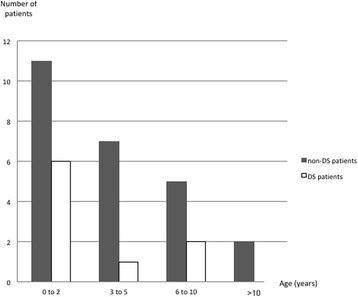Pulmonary hemosiderosis in children with Down syndrome: a national experience
- PMID: 29678139
- PMCID: PMC5910623
- DOI: 10.1186/s13023-018-0806-6
Pulmonary hemosiderosis in children with Down syndrome: a national experience
Abstract
Background: Pulmonary hemosiderosis is a rare and complex disease in children. A previous study from the French RespiRare® network led to two important findings: 20% of the children presented with both pulmonary hemosiderosis and Down syndrome (DS), and at least one tested autoantibody was found positive in 50%. This study investigates the relationships between pulmonary hemosiderosis and DS.
Methods: Patients younger than 20 years old and followed for pulmonary hemosiderosis were retrieved from the RespiRare® database. Clinical, biological, functional, and radiological findings were collected, and DS and non-DS patients' data were compared.
Results: A total of 34 patients (22 girls and 12 boys) were included, among whom nine (26%) presented with DS. The mean age at diagnosis was 4.1 ± 3.27 years old for non-DS and 2.9 ± 3.45 years old for DS patients. DS patients tended to present a more severe form of the disease with an earlier onset, more dyspnoea at diagnosis, more frequent secondary pulmonary hypertension, and an increased risk of fatal evolution.
Conclusions: DS patients have a higher risk of developing pulmonary hemosiderosis, and the disease seems to be more severe in this population. This could be due to the combination of an abnormal lung capillary bed with fragile vessels, a higher susceptibility to autoimmune lesions, and a higher risk of evolution toward pulmonary hypertension. A better screening for pulmonary hemosiderosis and a better prevention of hypoxia in DS paediatric patients may prevent a severe evolution of the disease.
Keywords: Autoimmunity; Celiac disease; Children; Down syndrome; Interstitial lung disease; Pulmonary hemosiderosis; Pulmonary hypertension; Vasculitis.
Conflict of interest statement
Ethics approval and consent to participate
The database and data collection have been approved by French national data protection authorities (CNIL n°908,324 and CCTIRS n°08.015bis). Each patient and/or his or her legal representatives were informed prior to entering their data in the database.
Competing interests
The authors declare that they have no competing interests.
Publisher’s Note
Springer Nature remains neutral with regard to jurisdictional claims in published maps and institutional affiliations.
Figures



References
-
- Drew WL, Finley TN, Golde DW. Diagnostic lavage and occult pulmonary hemorrhage in thrombocytopenic immunocompromised patients. Am Rev Respir Dis. 1977;116(2):215–221. - PubMed
Publication types
MeSH terms
LinkOut - more resources
Full Text Sources
Other Literature Sources
Medical

